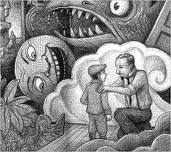 “It’s easy to become anything you wish…so long as you’re willing to forfeit your soul.”
“It’s easy to become anything you wish…so long as you’re willing to forfeit your soul.”
This graphic novel is a super-award winner (the heavy hitters- the Printz Award and a National Book Award finalist nomination). It is composed of three stories: the folk tale Monkey King, an blonde-haired, blue eyed student whose cousin, a very stereotyped Asian caricature, comes to visit, and then Jin’s story.
Jin’s parents are Chinese immigrants, who met in graduate school. Until third grade, Jin lived in Chinatown in San Francisco, and had a good group of friends and a community. However, when the family moves and he transfers to a different school, things get complicated. Jin has to listen to the tired Chinese jokes, racial slurs and hurtful, ignorant comments of his classmates. He’s not sure how to defend himself when other students ask if he eats dogs, or if he’s related to the other Asian student in the class.
third grade, Jin lived in Chinatown in San Francisco, and had a good group of friends and a community. However, when the family moves and he transfers to a different school, things get complicated. Jin has to listen to the tired Chinese jokes, racial slurs and hurtful, ignorant comments of his classmates. He’s not sure how to defend himself when other students ask if he eats dogs, or if he’s related to the other Asian student in the class.
When he develops a crush on a pretty, blonde girl, and one of the other white students confronts him and asks him not to date her, all of Jin’s internalized self-hatred combusts, and he ends up saying some very hurtful things to his only true friend.
 Told in sections that juxtapose myths of the Monkey King, Jin’s internal thoughts, and his life at school, this graphic novel is provocative and interesting. I finished it quickly, but it left me thinking for a long time after I stopped reading. The honest reflection of prejudice and commentary on the process of assimilation made for some good dinner-table conversation.
Told in sections that juxtapose myths of the Monkey King, Jin’s internal thoughts, and his life at school, this graphic novel is provocative and interesting. I finished it quickly, but it left me thinking for a long time after I stopped reading. The honest reflection of prejudice and commentary on the process of assimilation made for some good dinner-table conversation.
Happy Reading!
Yang, Gene Luen. American Born Chinese. New York: First Second, 2006. Ages 12-15.
If you liked this graphic novel, this author has written several other books. Check out Gordon Yamamoto and the King of the Geeks or The Motherless One. If you want to explore books by other authors, my favorite graphic novel is Persepolis by Marjane Satrapi.






